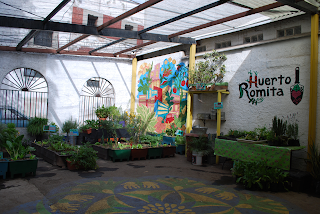Choosing varieties is just one of many steps to growing fruit trees successfully. Let’s work through some of the challenges participants in a community garden will face before getting down to specific variety recommendations.
 |
| An 'urban ag' garden demonstrating light limitations and special protection requirements. |
Site Challenges
As we have discussed in other Farm Calls, soil quality and light availability are limiting factors in urban settings. Fruit tree crops are perennial, demanding well-drained soils. Soil preparation to improve drainage, compaction, and fertility deficiencies requires seasons of effort in advance of fruit tree planting. In addition, as tree fruit extension agent Win Cowgill reminds us, community gardeners are unlikely to harvest any fruit unless the trees are protected from vandalism, birds, and squirrels.
Growing Challenges
The community garden will need members trained in the skills of growing fruit trees. Pruning, thinning, controlling pests and diseases, and spraying require a significant commitment in both learning and performance of the tasks. Training is offered through Rutgers Cooperative Extension.
Recommended Varieties for this Community Garden
Variety choice is more involved than taking into account regional hardiness; consider site specificity, pollination group (for apples), rootstock, and disease susceptibility. Variety choice is best made in consultation with your County Extension Agent who has experience in site evaluation and knowledge of variety characteristics.
Rutgers fruit breeder, Joe Goffreda, offers the following varieties stressing the importance of selecting early maturing, disease tolerant varieties to reduce losses from diseases and insects.
Peach
‘Desiree’ is an early season (ripens early July) yellow fleshed, full-flavored high quality peach. This peach was developed at Rutgers for resistance to bacterial spot disease.
Protecting apple trees from diseases such as Apple Scab and Fireblight is so important that the PRI Cooperative Disease Resistant Apple Breeding Program was created and has been in existence since 1945. A collaboration of Purdue, Rutgers, and the University of Illinois, the program has released about 15 named apple scab immune cultivars, which also produce excellent fruit.
‘Pristine’ is our earliest disease tolerant apple developed by the PRI. Ripening in mid to late July, it is a yellow, spicy apple. Joe Goffreda recommends selecting Bud 9 as a dwarfing rootstock to protect against Fireblight.
‘Redfree’ is our earliest red-skinned, disease tolerant apple developed by the PRI. Ripening in mid-August, it is an attractive red apple with a balanced sweet-tart, spicy flavor.
Win Cowgill offers three additional later maturing varieties with NJ adaptation and Apple Scab and Fireblight tolerance: Enterprise from PRI (good after storage), Jonafree from PRI, and Liberty (so named because its resistance requires fewer sprays).
Tips
When ordering trees, use professional nurseries and pay attention to rootstock details. Bud 9 rootstock is winter hardy, dwarfing, and disease resistant. Apple trees grafted on precocious rootstocks like M-9 have characteristics of dwarfing and tolerance for varying soil conditions. Precocious rootstocks bear fruit earlier in the life of the tree, and keep tree size manageable in small spaces.
Single 10 foot tree stakes, anchored 2.5 to 3 feet in the ground should be adequate for small spaces.
For higher market quality, Joe Goffreda says, “consider bagging the fruit early in the season to further reduce losses from disease and insects, as is practiced in Japan.” Daniel Ward, Specialist in tree fruit, studied on-tree bagging as a production technique and found, while labor intensive, it can provide significant pest protection.
There will be times when spraying trees is necessary, even if you intend to grow them with minimal pesticide applications. Viewing John Grande’s video guides on modifying backpack sprayers is time well spent for small-scale operators.
Taking a Broad View
‘Urban ag’ community gardens benefit participants on a number of levels; arguably the most important is a sense of accomplishment of producing supplemental food for themselves, their family, and sharing in the community.
Fruit is recognized for health promotion properties and hand-fruits like apple and peach are attractive, portable kid snacks. However, fruit trees are not so easily grown as annual crops. Choosing varieties is just one of many steps to growing fruit trees successfully. Without site preparation and training of the participants, the likelihood of tree survival and subsequent benefits of a sense of personal accomplishment and health promotion, is zero. Before undertaking the long term commitment of fruit trees, meet with your county agent on-site to discuss training options and fully understand the requirements for your particular site.

